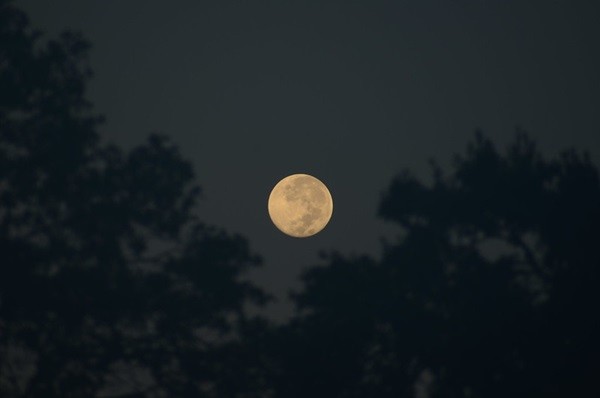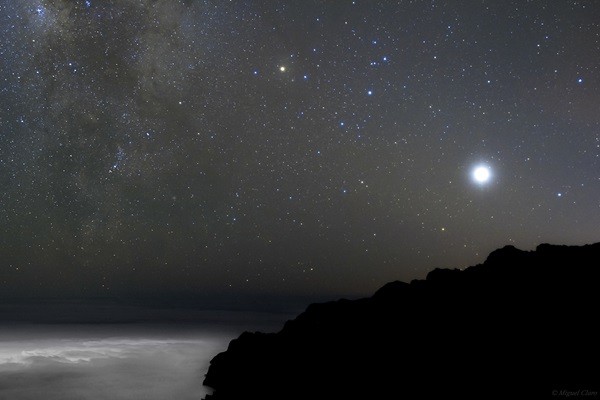Blog
What colors are the planets in our solar system? And why are they so different?
Friday, October 22nd 2021 04:42 PM
The planets of the solar system are varied in their appearance. Mercury is slate gray while Venus is pearly white, Earth a vibrant blue, and Mars a dusky red. Even the gas giants are different, Neptune and Uranus an opaque blue, while Jupiter and Saturn are mostly beige with brilliant red-brown belts. But why are these planets so different?
It starts at the beginning
As it turns out, stars and their planets form at the same time from a disk of gas and dust known as a solar nebula. Most of the gas — predominately hydrogen and helium — was swallowed by our young star; no surprise considering the Sun contains somewhere between 99.8 and 99.9 percent of the solar system’s total mass.
At the same time, debris mixed into the nebula collided over and over again, eventually accreting into planetesimals and then protoplanets. Jupiter, Saturn, and even Neptune and Uranus were able to pull in some of nebula’s hydrogen and helium to swaddle their cores, causing th...
Read More
Read More
How doomed matter reveals the inner secrets of black holes
Thursday, October 21st 2021 04:31 PM
The brightly glowing accretion disk of material around a black hole encodes vital information about the extreme object it encircles.
Black holes are regions of austere darkness, gobbling up everything — even light — that strays too close. But the environment immediately surrounding a black hole is not so dark. Astronomers often spot copious amounts of light streaming from there, emerging from a thin disk of matter called an accretion disk.
A black hole imprints all of its essential characteristics onto its accretion disk, including its mass, spin, and gravitational field. In the last 10 years, studying the light from such disks has become one of the central methods astronomers use to analyze black holes. And accretion disks supply the only known method for measuring the spin of supermassive black holes, which reside at the center of all large galaxies.
Perhaps the most exotic message sent to us by a black hole’s accretion disk relates to the gravity it feel...
Read More
Read More
Ask Astro: How much of the universe can we observe?
Wednesday, October 20th 2021 04:36 PM
NASA’s Ultraviolet Coverage of the Hubble Deep Field survey captures much of the observable universe in this image.
What is the difference between the observable universe and the whole universe?
About 13.8 billion years ago, the Big Bang kicked off the universe, filling it with matter, dark matter, and dark energy. Since then, the universe has expanded into what we see (and don’t see) today.
Light, the fastest thing in the universe, has a speed limit of about 186,000 miles per second (about 300,000 km/s). This means that, from our viewpoint, we can only see as far as the light from the farthest objects has been able to travel in the time since the Big Bang. You can essentially think of the observable universe as a sphere surrounding any point in the cosmos — in our case, Earth. The radius of that sphere is 46 billion light-years.
It may seem counterintuitive to think of the cosmos as existing beyond the observable universe, especially if even light has a f...
Read More
Read More
Image of the Day - Mars Sample Return Artist's Concept
Tuesday, October 19th 2021 05:31 PM
This illustration shows a concept for a set of future robots working together to ferry back samples from the surface of Mars collected by NASA's Mars Perseverance rover.
NASA and the European Space Agency (ESA) are solidifying concepts for a Mars sample return mission that would seek to take the samples of Martian rocks and other materials being collected and stored in sealed tubes by NASA's Mars Perseverance rover and return the sealed tubes to Earth.
According to the current concept, NASA would deliver a Mars lander in the vicinity of Jezero Crater, where Perseverance (left) will have collected and cached samples. The Sample Retrieval Lander (right) would carry a NASA rocket (the Mars Ascent Vehicle), along with ESA's Sample Fetch Rover (center) that is roughly the size of the Opportunity Mars rover. The fetch rover would gather the cached samples and carry them back to the lander for transfer to the ascent vehicle; additional samples could also be delivered directly by Per...
Read More
Read More
The Sky This Week: Observe the Moon
Friday, October 15th 2021 04:31 PM
Setting satellite: The bright Moon sets in this photo taken October 1, 2012.
Friday, October 15
The Moon passes 4° south of Jupiter in Capricornus at 6 A.M. EDT. You can’t see them then — both are below the horizon — but they are visible in the sky tonight after sunset. By then, the Moon has shifted over into Aquarius and sits 8.2° east-southeast of Jupiter. The bright star Deneb Algedi (magnitude 2.9) sits between them, about one-third of the way on a line drawn from Jupiter (magnitude –2.6) to the Moon.
Look to the right (west) of Jupiter and you’ll find Saturn, glowing softly at magnitude 0.5 on the other side of Capricornus. It sits 6° southeast of Beta (β) Capricorni. The ringed planet looks stunning through a telescope, with its trademark rings stretching 40" and several small moons around it, including Enceladus, Rhea, Dione, and Tethys. Brighter Titan sits just over 2' away, currently west-southwest of the planet.
Sun...
Read More
Read More
image of the Day - Lucy: Inspiration and Asteroids
Wednesday, October 13th 2021 04:19 PM
NASA's Lucy mission will explore a record-breaking number of asteroids, flying by one asteroid in the solar system’s main asteroid belt, and by seven Trojan asteroids.
This illustration is of the Lucy mission's seven targets: the binary asteroid Patroclus/Menoetius, Eurybates, Orus, Leucus, Polymele, and the main belt asteroid DonaldJohanson.
Lucy is scheduled to launch on Saturday, Oct. 16, 2021, at 5:34 a.m. EDT.
Image Credit: NASA/Goddard Space Flight Center Conceptual Image Lab
Read More
Read More
The Sky This Week: All eyes on Uranus
Monday, October 11th 2021 04:46 PM
A distant giant: The Hubble Space Telescope captured this colorful image of the ice giant Uranus in November 2016.
Friday, October 8
Today, tomorrow, and Sunday, the Royal Astronomical Society (RAS) is hosting a public livestream of the planet Uranus, as observed with NASA’s Infrared Telescope Facility on Mauna Kea in Hawaii. The livestream will run each morning from 4 A.M. through 11:55 A.M. EDT on the RAS YouTube Channel. But these observations are more than just a chance to enjoy clear views of the ice giant — they will also be used to create the most detailed infrared map of the planet to date. Researchers hope to catch the planet’s southern aurora to chart and learn more about it.
If you want to find Uranus for yourself, it rises around 7:30 P.M. local time and will be well poised for observation in the east a few hours later. It’s approaching opposition, which it will reach next month. You’ll find it in the constellation Aries, whe...
Read More
Read More
The Sky This Week: New Moon means dark skies
Friday, October 1st 2021 04:32 PM
Venus and Scorpius: This picture, taken near Roque de Los Muchahos in La Palma, Spain, showcases brilliant Venus inside a stellar asterism that forms the constellation Libra the Scales. At left is the central region of the Milky Way and most of the constellation Scorpius, with its brightest star Antares at top center.
Friday, October 1
The 66-mile-wide (107 kilometers) asteroid 40 Harmonia reaches opposition this afternoon at 3 P.M. EDT. You can find it in Cetus the Whale tonight, visible all evening and into the early morning hours of the 2nd.
An hour after sunset, look east, where magnitude 3.6 Iota (ι) Ceti is rising, already more than 6° high. Harmonia sits 7.7° east-northeast of this star. You can also use 5th-magnitude 20 Ceti as a jumping-off point: Harmonia is about 3.6° southwest of this luminary, roughly level with it in altitude as they rise. The longer you wait, the higher Harmonia will rise in the sky and the easier it will be to spot it...
Read More
Read More
Understanding just how big solar flares can get
Wednesday, September 29th 2021 05:08 PM
On May 1, 2019, the star next door erupted.
In a matter of seconds, Proxima Centauri, the nearest star to our Sun, got thousands of times brighter than usual — up to 14,000 times brighter in the ultraviolet range of the spectrum. The radiation burst was strong enough to split any water molecules that might exist on the temperate, Earth-sized planet orbiting that star; repeated blasts of that magnitude might have stripped the planet of any atmosphere.
It would be bad news if the Earth’s sun ever got so angry.
But the Sun does have its moments — most famously, in the predawn hours of Sep. 2, 1859. At that time, a brilliant aurora lit up the planet, appearing as far south as Havana. Folks in Missouri could read by its light, while miners sleeping outdoors in the Rocky Mountains woke up and, thinking it was dawn, started making breakfast. “The whole of the northern hemisphere was as light as though the Sun had set an hour before,” the Times of Londo...
Read More
Read More
What is the Harvest Moon effect?
Monday, September 27th 2021 04:44 PM
A Full Harvest Moon hangs low in the sky above fields in Nebraska.
For those in the Northern Hemisphere, the autumnal equinox marks the start of fall. This year, the equinox falls on Wednesday, September 22 at 3:21 P.M. EDT. At that time, the Sun will cross the celestial equator — the projection of Earth’s equator out into space in all directions — heading from north to south.
The Full Moon that occurs closest to the autumnal equinox has a special name: the Harvest Moon. This year, the Harvest Moon falls just a few days before the equinox, on Monday, September 20, at 7:55 P.M. EDT. And because of some nifty celestial geometry, it brings with it a special effect called, appropriately, the Harvest Moon effect.
What is the Harvest Moon effect? Put simply, it’s a span of several days during which the Full (or nearly Full) Moon rises at almost the same time each night. This means several nights in a row receive lots of bright moonlight — a boon to fa...
Read More
Read More









